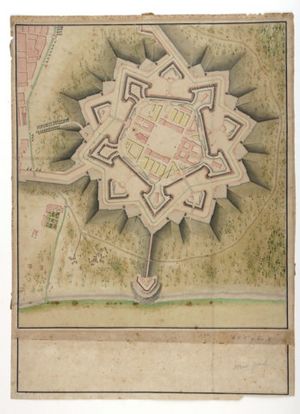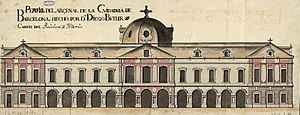Citadel of Barcelona facts for kids
The Citadel of Barcelona (also known as Ciudadela de Barcelona in Spanish or Fortalesa de la Ciutadella in Catalan) was a huge fortress built in Barcelona, Spain. Its construction started in 1714. At the time, it was the biggest fortress in Europe! It could hold 8,000 soldiers.
A military engineer named Marquis of Verboom designed the Citadel. He also became its first governor in 1718.
Even though most of the fortress was taken down in the mid-1800s, some parts are still there. For example, its old arsenal (where weapons were stored) is now the Palau del Parlament de Catalunya. This is where the Catalan Parliament meets. The rest of the area became the city's main park, the Parc de la Ciutadella, in 1872. An architect named Josep Fontserè designed the park.
Contents
Why the Citadel Was Built

Barcelona has a hill called Montjuïc on its southwestern side. Montjuïc Castle is on top of this hill. In the 1600s, during the Catalan Revolt, people from Catalonia fought against forces from Madrid. They even won a battle at Montjuïc in 1641.
Later, during the War of the Spanish Succession (1701–1715), Barcelona was attacked from Montjuïc Castle. The city was under siege for 13 months in 1714 by the army of King Philip V of Spain. King Philip V was from the Bourbon family.
When Barcelona finally fell, King Philip V wanted to make sure the people of Catalonia couldn't rebel again. So, he ordered the Citadel of Barcelona to be built on the opposite side of the city from Montjuïc Castle. This way, he could control Barcelona better.
Building the Fortress
The Citadel was built in an area called La Ribera. To make space for the huge fortress, half of this district was torn down. This meant many people lost their homes and had nowhere to live.
In 1718, the leader of Catalonia, Francesco Pio de Savoya, asked Verboom (the Citadel's designer) to plan a new neighborhood for the people who had lost their houses. However, these plans were never put into action.
The Barceloneta Neighborhood
In 1749, another leader of Catalonia, Jaime de Guzmán-Dávalos y Spínola, asked Juan Martín Cermeño to build a new neighborhood called Barceloneta. This area was rebuilt around the fortress, in the Ciutat Vella (Old City) part of Barcelona. One goal of this project was to help the people who had lost their homes in La Ribera, though this was not the main reason for building it.
Construction of Barceloneta started in 1753. By 1757, 244 houses were built. Two years later, there were 329 houses, home to 1,570 people. The project also included building the Church of Sant Miquel del Port, which was finished in 1755.
History of the Citadel
The Peninsular War
In 1808, a French general named Guillaume Philibert Duhesme led 14,000 soldiers into Spain. On February 29, another French general, Giuseppe Lechi, marched his troops through Barcelona. They suddenly entered the Citadel. The Spanish soldiers guarding the fortress didn't understand what was happening. The French took over the Citadel without a fight.
Changes in the Mid-1800s
By 1841, the people of Barcelona hated the fortress. The city leaders decided to destroy it. However, just two years later, the Citadel was rebuilt under the rule of Maria Christina of the Two Sicilies.
In 1842, General Espartero ordered the bombardment of Barcelona. This attack destroyed many buildings inside the fortress and damaged its walls.
By 1869, the political situation in Spain had become more open. General Juan Prim decided to give what was left of the fortress to the city. Some of the remaining buildings were then torn down. The area was later turned into the beautiful Parc de la Ciutadella that we see today.
See also
 In Spanish: Ciudadela de Barcelona para niños
In Spanish: Ciudadela de Barcelona para niños



